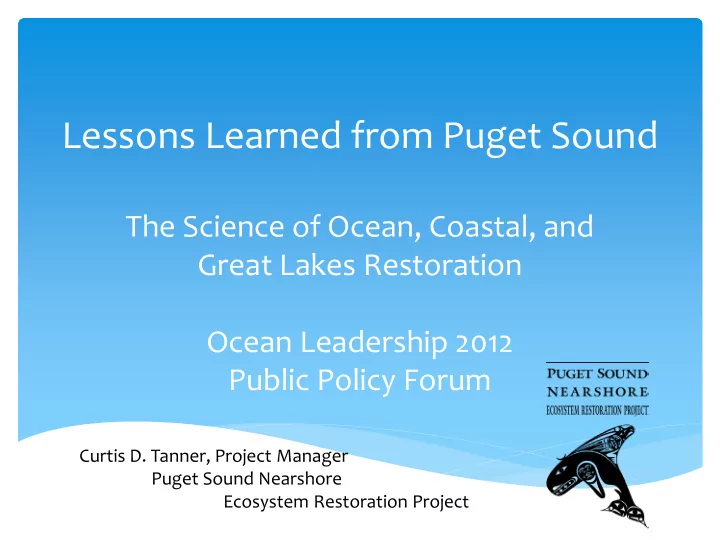

Lessons Learned from Puget Sound The Science of Ocean, Coastal, and Great Lakes Restoration Ocean Leadership 2012 Public Policy Forum Curtis D. Tanner, Project Manager Puget Sound Nearshore Ecosystem Restoration Project
Puget Sound Nearshore Ecosystem Restoration Project (PSNERP) Background ∗ Puget Sound Nearshore General Investigation Study • Goal : Identify nearshore ecosystem problems and develop a portfolio of solutions to protect and restore Puget Sound • Cost-share between Corps of Engineers and Wash. Dept. of Fish & Wildlife • Many other Partners Working for Water Resources Development Act (WRDA) Authorization
Puget Sound, Washington Semi-Enclosed Coastal Sea ∗ Expansive fjord ∗ Large river deltas ∗ Steep coastline with narrow nearshore zone ∗ Mixed sand/gravel beaches ∗ Strong regional gradients • tides, wave exposure, salinity ∗ Ecology strongly linked to geology and physical processes ∗ Diverse shoreline ecosystems ∗ Rich biological resources
Nearshore Ecosystems The shallow water of estuarine deltas & marine shorelines… From the top of the coastal bank… To water depths where light supports plant growth, and… Up rivers to the end of tidal influence.
Analysis of Historical Change in Puget Sound Photo of Chambers Creek mouth 2006, from Washington Dept. of Ecology
Analysis of Historical Change in Puget Sound
Science-Based Problems in Puget Sound 1. Barriers in large river deltas restrict the movement of fresh water and tides.
Science-Based Problems in Puget Sound 1. Barriers in large river deltas restrict the movement of fresh water and tides. 2. Small coastal inlets have been blocked off and filled in.
Science-Based Problems in Puget Sound 1. Barriers in large river deltas restrict the movement of fresh water and tides. 2. Small coastal inlets have been blocked off and filled in. 3. Armoring along beaches and bluffs prevents sand and gravel from replenishing beaches and intertidal areas.
Science-Based Problems in Puget Sound 1. Barriers in large river deltas restrict the movement of fresh water and tides. 2. Small coastal inlets have been blocked off and filled in. 3. Armoring along beaches and bluffs prevents sand and gravel from replenishing beaches and intertidal areas. 4. Nearshore wetlands have been eliminated.
Science-Based Problems in Puget Sound 1. Barriers in large river deltas restrict the movement of fresh water and tides. 2. Small coastal inlets have been blocked off and filled in. 3. Armoring along beaches and bluffs prevents sand and gravel from replenishing beaches and intertidal areas. 4. Nearshore wetlands have been eliminated. 5. The shoreline has become shorter, simpler, and more artificial.
Science-Based Problems in Puget Sound 1. Barriers in large river deltas restrict the movement of fresh water and tides. 2. Small coastal inlets have been blocked off and filled in. 3. Armoring along beaches and bluffs prevents sand and gravel from replenishing beaches and intertidal areas. 4. Nearshore wetlands have been eliminated. 5. The shoreline has become shorter, simpler, and more artificial. 6. Many places are affected by multiple types of changes.
Solutions for the Puget Sound Nearshore – Restoration Objectives 1. Restore large river deltas Reconnect to tides and rivers • 2. Restore beaches and spits Reestablish sediment input, transport • and accretion 3. Restore coastal embayments Restore shoreline complexity and • length Remove tidal barriers • 4. Improve habitat diversity and connectivity
Solutions for the Puget Sound Nearshore – Restoration Objectives 1. Restore large river deltas Reconnect to tides and rivers • 2. Restore beaches and spits Reestablish sediment input, transport • and accretion 3. Restore coastal embayments Restore shoreline complexity and • length Remove tidal barriers • 4. Improve habitat diversity and connectivity To benefit important resources, including salmon, shorebirds, shellfish and PEOPLE!
Observations and Lessons Learned Science- Based ∗ Grounding in independent science ∗ Promoting a strategic Strategic approach ∗ Engaging diverse partners Partnerships
For more info contact: Curtis D. Tanner curtis.tanner@dfw.wa.gov (360) 902-2815 www.pugetsoundnearshore.org
Recommend
More recommend